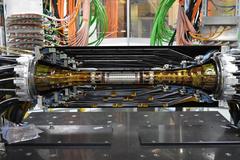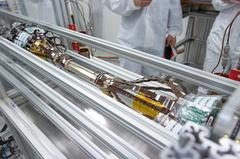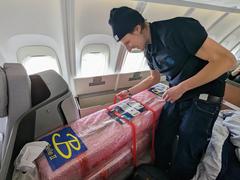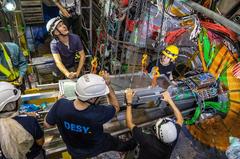URL: https://www.desy.de/news/news_search/index_eng.html
Breadcrumb Navigation
DESY News: Made in Germany: World’s thinnest pixel vertex detector installed in Japan
News
News from the DESY research centre
Made in Germany: World’s thinnest pixel vertex detector installed in Japan
The Pixel Vertex Detector, which is about the size of a soda can and is the innermost sub-detector of the international experiment Belle II, has been successfully installed at its final location at the SuperKEKB electron–positron collider at the KEK laboratory in Japan. The device, which is designed to detect the signals of certain particle decays that could shed light on the origin of the observed imbalance of matter and antimatter in the universe, has ventured a long way over a long time from its production site in Munich to its final destination in Japan.

The PXD, which is about the size of a beverage can, comprises 20 modules, each made of 75-micrometre-thin silicon strands. (Photo: KEK)
“The B-meson system is an ideal laboratory to study one of the most fundamental symmetries in nature: The violation of charge parity symmetry is one of three conditions that must be fulfilled to explain why today's universe consists almost entirely of matter,” says DESY scientist Carsten Niebuhr, who is the PXD project leader. “The high precision of the Belle II detector combined with the unprecedented statistics of the electron-position collisions at SuperKEKB provide unique opportunities to study CP violation and other interesting phenomena in much greater detail.”

Der PXD in einem Reinraum-Teststand bei DESY. Die Inbetriebnahme erfolgte unter der Leitung von DESY und unter Beteiligung zahlreicher Institute in ganz Deutschland. (Bild: DESY / Marta Mayer)
The detector flies business class
An earlier but incomplete version of the PXD was already installed at Belle II in 2018, but this new addition will be able to handle the higher-luminosity that SuperKEKB is expected to deliver in the coming years. In order to get the detector to Japan, it first needed to be transported by road from its assembly site at MPP in Munich to DESY for critical performance tests and optimisation of detector parameters. “Every bump in the road almost gave me a heart attack,” says PXD commissioning leader Arthur Bolz, who, together with his colleagues, had to overcome numerous unexpected problems that arose when operating a complete PXD half-shell for the first time.

Um das PXD von Hamburg nach Japan zu transportieren, verpackte das Team es speziell und platzierte es in einem entsprechend geräumigen Bereich des Flugzeugs: der Business Class. (Foto: DESY / Arthur Bolz)
PXD2 starts working at the beginning of 2024
“The commissioning and installation of the PXD required not only the preparation and insertion of the very fragile detector itself, but also the commissioning of the associated complex service systems, consisting of customised power supplies and readout electronics. In particular, the very limited space within the detector volume made this an extremely challenging task, which required close cooperation with several other detector groups in order to avoid potential conflicts,” says DESY scientist Fabian Becherer, who spent several months at KEK as a member of the PXD commissioning team.

Der PXD wird in Japan innerhalb der Struktur des größeren Belle II-Experiments installiert. (Bild: Ralf Farkas, Uni Bonn)
“It is a great achievement by DESY, the Max-Planck Institute MPP in Munich and several German universities to design, construct and install this unique, high-tech detector for the Belle II experiment at KEK,” says DESY Director for Particle Physics Beate Heinemann. “I want to thank and congratulate all those involved, and am excited about the upcoming SuperKEKB run to probe very high energy scales through B mesons and tau leptons with the improved Belle II detector and higher delivered luminosity.”
Involved in the PXD’s design and construction have been the University of Bonn, DESY, the University of Gießen, the University of Göttingen, the Karlsruhe Institute of Technology, the University of Mainz, the Max Planck Institute for Physics in Munich, the University of Munich, the Technical University of Munich, and the Semiconductor Laboratory of the Max Planck Society. Other institutes in Spain and Czechia also contributed.
Laci Andricek from the Semiconductor Laboratory in Munich and co-developer of the PXD sums up: “It is both exciting and relieving to be able to witness how the PXD, from the conception of the detector, to the development and production of the sensors and modules at the Semiconductor Laboratory of the Max Planck Society, to the integration at MPP and DESY, finally arrives at its destination.”
The German research groups in the Belle II experiment are funded by the following institutions and programmes:
- Alexander von Humboldt Foundation
- Federal Ministry of Education and Research (BMBF)
- German Research Foundation (DFG), in particular within the framework of the Excellence Strategy of the German Federal Government and the Federal States:
- "ORIGINS": EXC-2094 - 390783311
- "Quantum Universe": EXC-2121 - 390833306
- European Research Council - European Union's Horizon 2020 - grant agreement No 822070
- Helmholtz Association
- Max Planck Society



